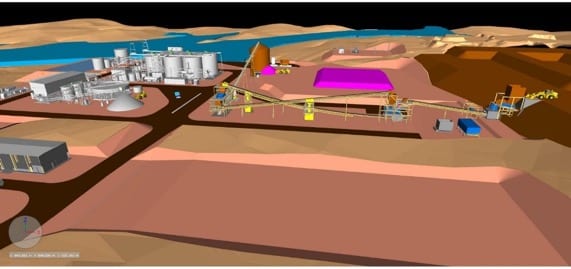Plant Design Option Study Examined 4Mtpa Option
Big River Gold Ltd (ASX: BRV) has received results of the plant design option study completed for the Borborema Gold Project in Brazil by Wave International
The Option Study aimed to optimise proposed process plant designs and compare the resulting capital costs with those presented in (1) a Definitive Feasibility Study (DFS) completed by Wave in December 2019 and (2) an update completed by Wave and CPC Project Design (CPC) in July 2020.
The study was undertaken to ensure that the 2Mtpa Stage 1 Process plant proposed in the Updated DFS 2020 study was the most efficient use of capital and that the design and equipment choice would not incur additional costs or prevent a seamless transition to any future possible expansions in the project and plant throughput at a later date.
Previous scoping and feasibility studies released in November, 2012 and September, 2011 had considered a plant capable of processing up to 4Mtpa.
The ultimate size of any future expansion will be subject to ongoing studies and availability of process water and we are pleased that positive progress on the latter is being made in this regard. However, for the purposes of the Option Study the comparison assumed an expanded plant capacity of 4Mtpa, being the maximum plant capacity that the Borborema project is currently permitted for.
The main points derived from the Option Study include:
- Equipment and engineering options have been identified and the layout redesigned, with potential bottlenecks removed, so that the Stage 1 circuit can be expanded on the same pad footprint as was previously planned. No change was incurred in earthworks cost.
- An oversize single stage crusher replaced the 3 Stage crushing circuit.
- A review of recent developments of SAG mill usage in Brazil suggested improvements in equipment support which mitigated concerns about operational security. Consequently, a larger than previously planned 4500kW SAG mill was reinserted into the design along with a small ball mill (2250W). This would meet the requirements of a 2Mtpa throughput with some flexibility and in any future expansion an additional small ball mill would be sufficient to increase throughput up to 4Mtpa through the comminution circuit.
- Key equipment in the original designs contained 20%-30% design margin oversize. The CIL tankage in particular was judged to be oversized and consequently “right”-sized to allow space for an additional 6 tanks in a 4Mtpa expansion. This was considered operationally more efficient and also reduced capital expenditure.
- The process circuit layout was arranged to provide space for any future expansion for the above as well as the downstream elution circuit, gold room, filter shed and possible mica recovery circuit, if that is determined to be viable in the future.
- The current power line agreement and design for the 2Mtpa project has sufficient capacity to support a plant throughput up to 4Mtpa.
Big River has accepted the recommendations but note that some additional changes may still occur with the layout as determined by ongoing detailed engineering, such as the location of the electrical substation after discussions with the local power authority, but it is not believed they will have a material effect.
“We are very pleased with the results of the Option Study as it leads to a more efficient use of capital and a strong basis for future expansion studies. We also anticipate some encouraging outcomes as we move to establish more precision on the costings over the coming weeks,” Andrew Richards, Executive Chairman of Big River Gold.
“Despite the delays in securing finance during 2020, due in large part to difficulties related to the pandemic, the company considers itself to be in an excellent position moving forward given the funds raised in December 2020.
“The Company will not only resume the process of securing project finance but has sufficient cash reserves to significantly advance the project with detailed FEED engineering and infrastructure development in parallel with that process. These are areas that are normally only able to be progressed once project finance has been secured.”












